How to cook perfectly steamed and fluffy Jasmine rice on the stove, with step-by-step photos. Tips for cooking rice with cast-iron and stainless steel pans.
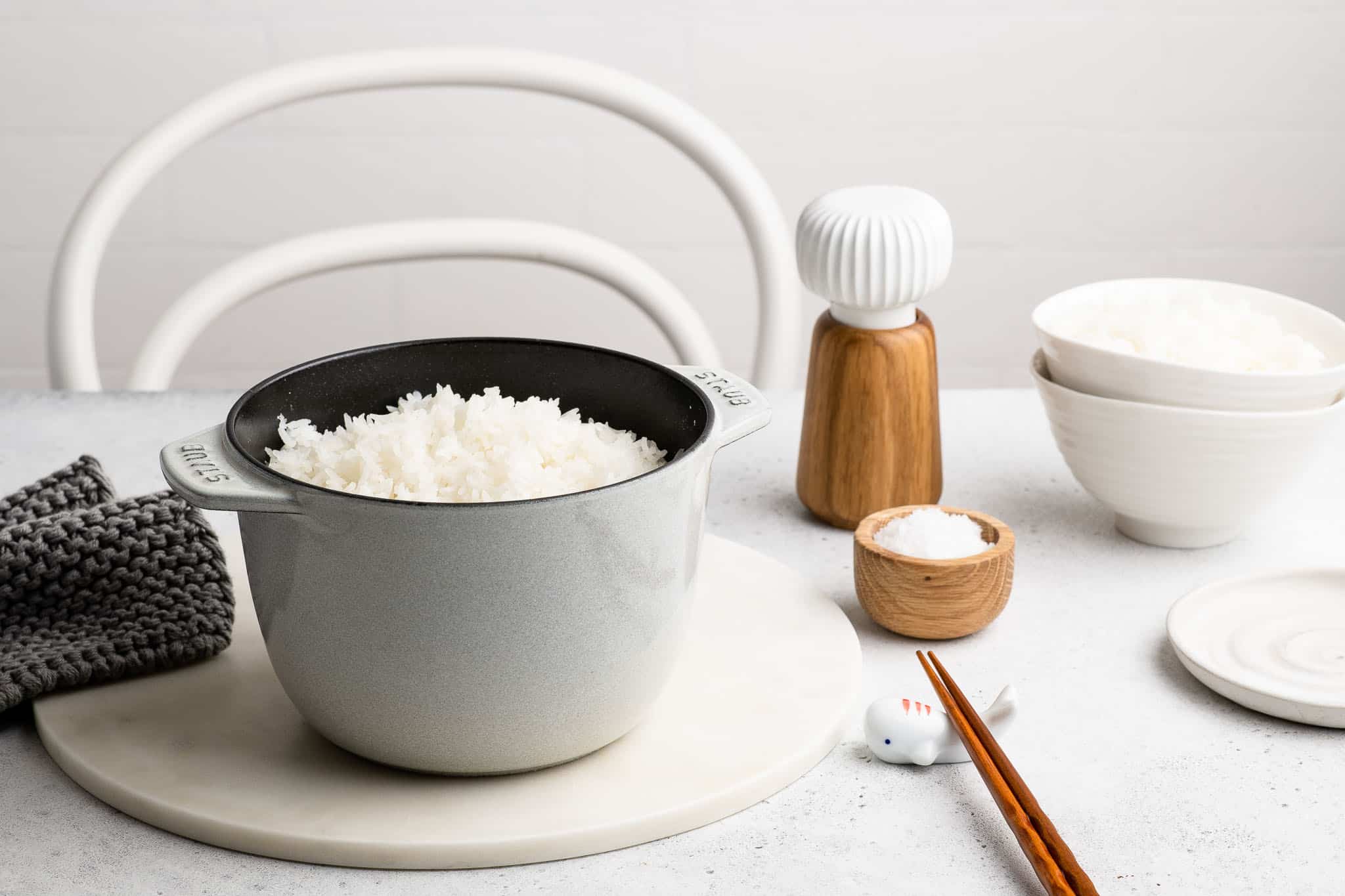
Have You Eaten Rice Yet?
In the Vietnamese language, we ask “Have you eaten rice yet?” as a way of saying “Hello” or “How are you?” The phrase is intended as a greeting, as a way of asking if you are well and healthy, if everything is going ok in your day.
Given that a lot of Vietnamese culture revolves around food, that one would discuss the next meal whilst sitting down to a meal, the question of whether one has eaten yet comes from a place of care and nurture. “Have you eaten rice yet?” is often a reminder that one should take time for themselves, to nourish oneself before getting back to the daily grind.
Daily Bowl of Rice
When I was growing up, there was not a meal that did not feature rice. We ate rice at breakfast, lunch and dinner. Even when I was at school, I would often open my lunch box to find some rice staring back at me – usually a fried rice or some steamed rice with exotic leftovers from dinner the night before.
In Asian culture, rice is served as an important accompaniment to many shared dishes. In our home, we eat rice about once or twice a week. It’s not very often for a French-Vietnamese family, but I think my mother would nonetheless be surprised by the frequency!
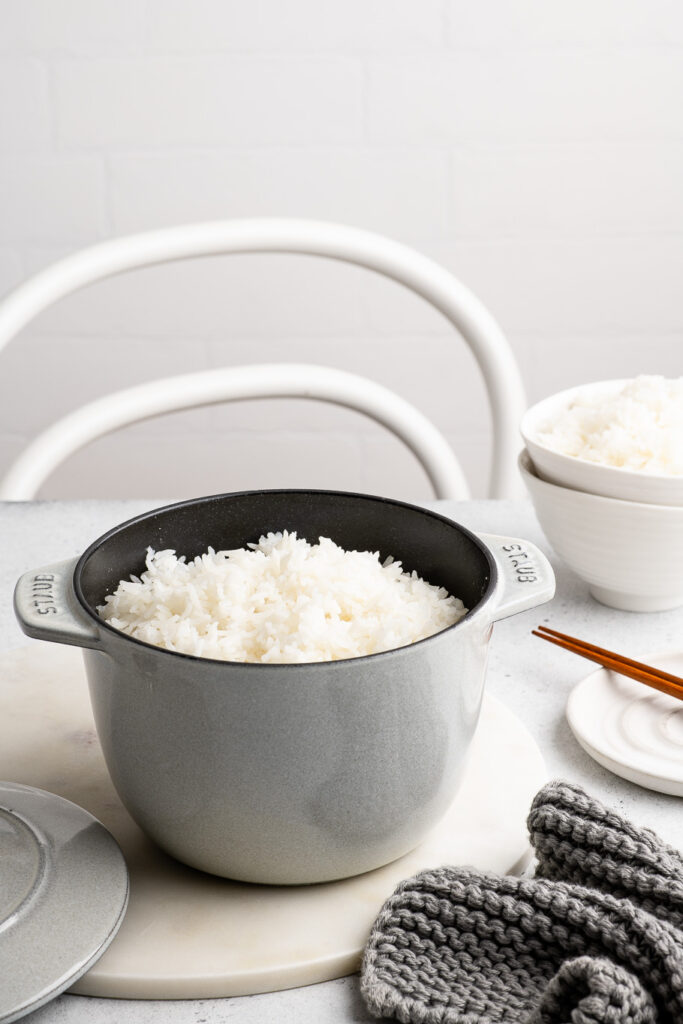
How to Cook Jasmine Rice
I am often asked what brand of rice cooker I own, and people are always shocked when I tell them that I don’t own a rice cooker. “But you’re Asian!”, they will cry in disbelief, “How do you possibly cook rice?” Even my Asian friends are astonished.
I have been cooking rice on the stove since I moved out of home. In the beginning, it made sense to cook rice this way because, when you are cooking rice for 1 or 2 people, you don’t need a fancy rice cooker. But even as my family has grown, the habit has stuck and I still continue to cook rice on the stove. I consider it to be a necessary skill 😉
Do You Need a Rice Cooker?
Many years ago, my aunt and uncle came over for dinner. Despite my efforts in preparing the main dish (a Thai chicken curry), it was the rice which became the topic of discussion during the meal. My aunt was shocked to see that I was cooking rice on the stove and somehow came to the conclusion that either we could not afford a rice cooker, or that I was not aware of the technological advancement in rice cooking. Some criticism was also directed at my mother for not teaching me how to use a rice cooker 😂
The next time we saw my aunt and uncle, they gifted us a shiny new rice cooker, which we gratefully accepted and used regularly until the non-stick coating started to peel off the bowl a few years later. Faced with the decision to replace the entire the appliance (which felt like a waste to us), or revert to cooking rice simply on the stove, we opted for the latter. I was also relieved to free up some valuable real estate on my kitchen bench.
Having used a rice cooker for several years, I found that, whether you cook rice on the stove or with a rice cooker, you still need to prepare and measure the rice the same way.
Many rice cookers come with its own measuring cup (generally 140 g), and the bowl will indicate how much water to add depending on how many cups of rice you use. But depending on how you like your rice cooked, you might still need to adjust the quantity of water used.
The main advantage of using a rice cooker is that it will automatically stop cooking after the cooking time has finished. Most models will then switch to a “keep warm” setting. This functionality, however, has never been that convincing for me. If you get started on the rice before cooking dinner, chances are that you will be in the kitchen anyway to remove the rice pot from the stove when the timer goes off.
I personally don’t think you need a rice cooker to cook rice, but I can see how it would be useful if, for example, you have a small stove (or no stove) and would prefer to plug in an electrical appliance to cook the rice. Also, most modern rice cookers do more than just cook rice, and it can be safer for some people to use a rice cooker.
Having said that, I think cooking rice on the stove is a useful skill to have 🙂

What Type of Pan to Use to Cook Rice
Whether you are using a stainless steel or cast-iron pan, I recommend using one which is just big enough to cook the amount of rice that you are using. You will need to allow some room for the rice to cook and expand, as well as allow enough room for the steam to cook the rice.
If the pan is too small, the water might overflow and the rice will end up too dry.
If you use a pan which is too big, the rice might cook quicker than expected.
As a guide, the rice will need about double the space to cook and expand.
Cooking Rice with Cast-Iron
When I saw this Staub Rice Cocotte, it was love at first sight. Prior to purchasing it, I used a regular stainless steel pan for cooking rice (see photos below). But owning a pot dedicated to cooking rice meant that I could free up a pan for cooking. Or that was my rationale anyway 😉
It’s also a very cute looking pot, and I love how my kids know that it is “the” rice pot. I love it so much that I actually have the same pot in various colours, although the grey one is designated for making rice.
This particular Staub Rice Cocotte makes enough rice for 4 people. If you need to make rice for more people, you will need to use a larger pot.
Cast-iron takes a bit longer to heat up, but when it does, it distributes the heat better, and it retains moisture better than other materials.
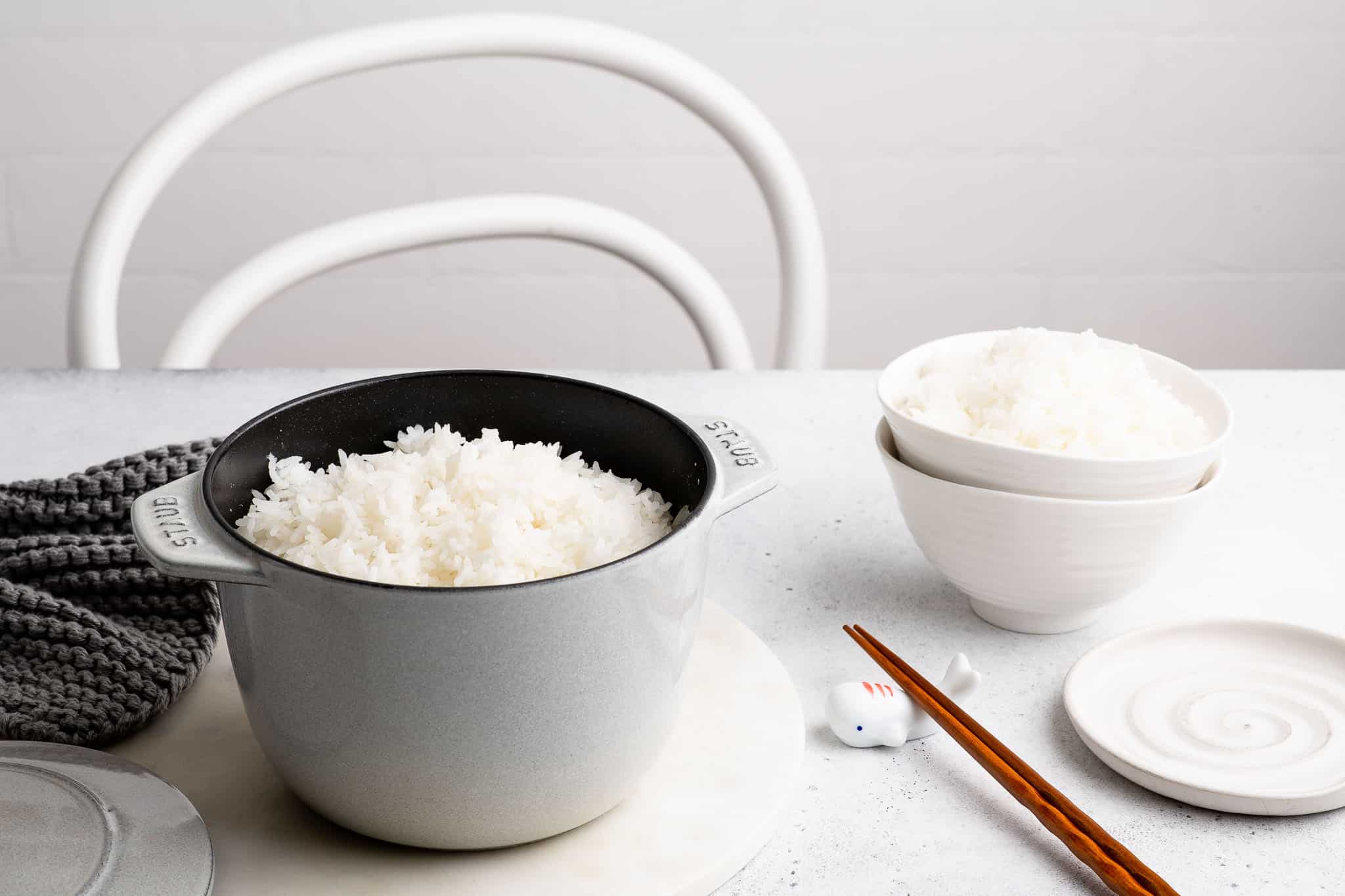
Cooking Rice on an Induction Stove
We moved homes a few years ago and our new kitchen came with a sparkling new induction stove.
An induction cooktop is a glass-top electric stove which uses electromagnetic waves to heat the cookware. The heat is transferred directly to the cookware, and through the cooktop itself. This means that less energy is used because the cooktop itself is not being heated; in fact, the cooktop remains somewhat cool to touch during cooking, which makes it safer to use.
For induction cooktops, you need to use cookware which is magnetic. The easiest way to test if your cookware is suitable for use on an induction stove is to simply test it with a magnet – the magnet should stick to the bottom of the pan.
I only cook with stainless steel and cast-iron pans, and either are suitable for using to cook rice on an induction stove.
Like with any stove, you will have to experiment with the heat settings. But I find induction stoves to be more precise, such that you can cook things on a low setting and know that it will be quite gentle. In fact, with induction stoves, you no longer need to use bain-maries or double boilers to melt chocolate or make sauces like Béarnaise Sauce; you can cook directly in the saucepan on low heat.
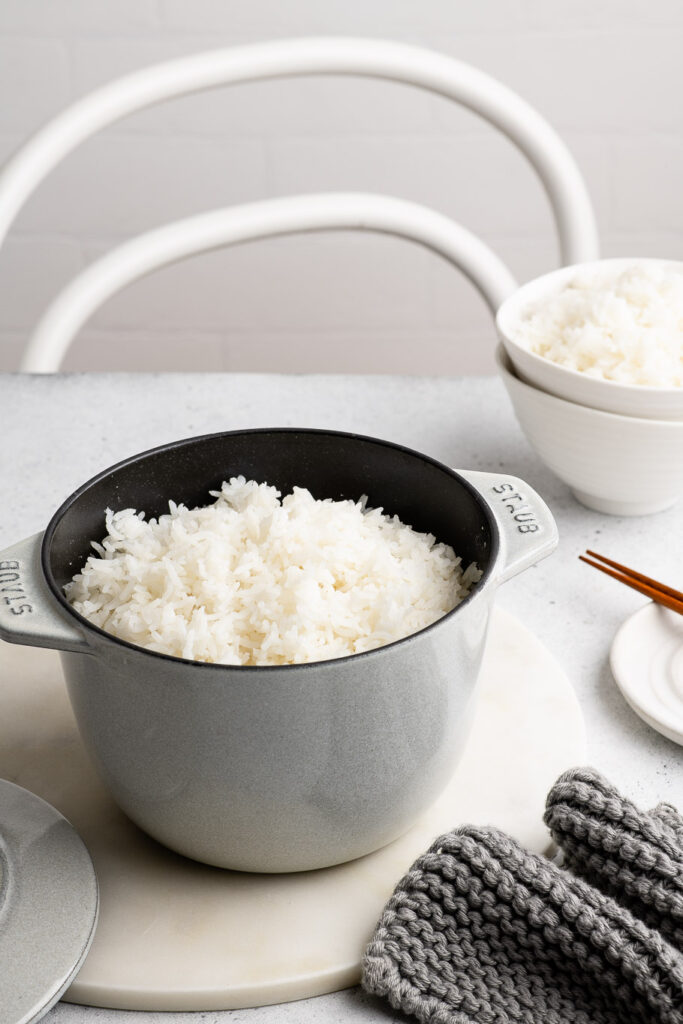
Knuckle Method
When I left home, my mother taught me how to cook rice on the stove. Her method involved measuring the water level until it reached the first knuckle on your forefinger when you touch the top of the rice. She used this method even if she was using a rice cooker.
It’s not a scientific method of cooking rice, but it strangely works, no matter how much rice and what size pot you are using.
Of course, when it came time to teach my own kids how to cook rice, their hands are much smaller than mine, and I quickly realised that the “knuckle method” had some limitations 😉
How Much Rice Per Person?
When planning how much rice to cook per person, estimate between 70 g and 100 g uncooked rice per person.
Measuring the Rice
Most rice cookers come with a “rice cooker cup”, which measures approximately 150 ml (filled to the brim), and which holds about 140 g of Jasmine rice when filled right to the brim.
So one “rice cooker cup” of uncooked rice generally makes enough rice for 2 people.
But if you have never owned a rice cooker, chances are that you don’t have a “rice cooker cup”. So the recipe below uses traditional measuring cups. Please see my Conversion Chart.
Ratio of Jasmine Rice to Water
Most recipes for Jasmine rice call for a ratio of 1:1.25 of rice to water.
My recipe for cooking Jasmine rice uses a ratio of 1:1.4 of rice to water.
I suggest looking at the instructions on your packet of rice to see what ratio they recommend, as different types of rice require slightly more or less water. Once the rice has cooked, if it tastes too dry, add a bit more water next time. If the rice is too moist, reduce the quantity of water.
Other Type of Rice
You can use the stovetop method below to cook other types of rice.
Use the same ratio for cooking sushi rice.
For Basmati rice, I use a ratio of 1:1.5 of rice to water.
How to Cook Jasmine Rice
The steps below are how I cook Jasmine rice on the stove. Many recipes for cooking rice will instruct you to bring the pot of rice to a boil before turning the heat all the way down for the remainder of the cooking time. This method requires less time to cook the rice. However, it also requires you to be hovering by the stove to keep an eye on when the pot, which my kids don’t have the patience for. Also, if you’re a busy cook, it’s also easy to forget about the rice and only be reminded when you are hit with the unpleasant aroma of burnt rice.
Which is why I came up with my method below; once you put the pot on the stove, you can set a timer and not worry about the rice while you get on with other things.
I taught my 8 year old daughter how to cook rice on the stove using the recipe below, and she is always so happy and proud to reveal the pot of perfectly cooked rice each time!
Step 1
Measure the rice and place it into a fine sieve. If the sieve is too big, the grains of rice might fall out.
Step 2
Rinse the rice in the sieve under cold running water. Use your hands to move the grains around in the sieve. As the starch is being washed away, the water will appear milky and cloudy. Once the water starts looking clear, you can stop. This step should only take 1-2 minutes.
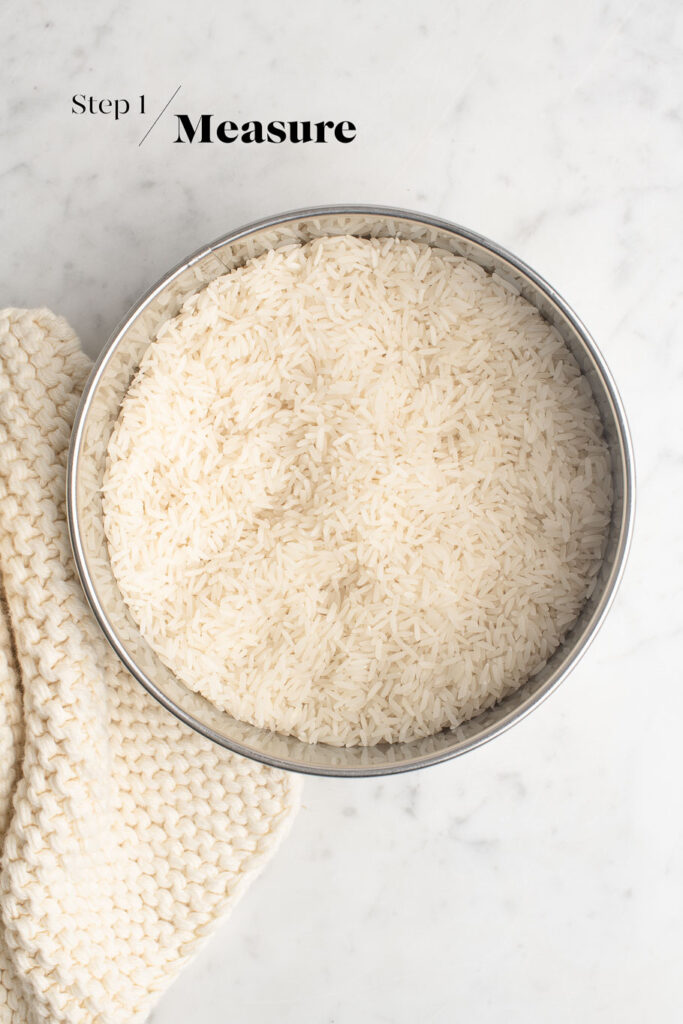
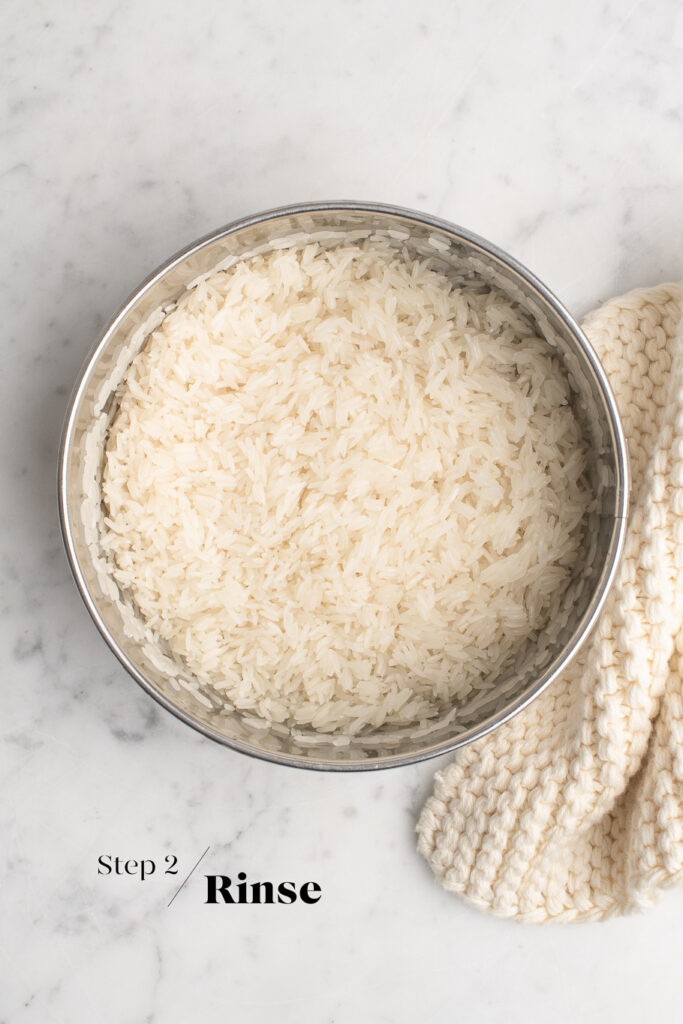
Step 3
Transfer the rinsed rice to a saucepan which has a tight-fitting lid.
Step 4
Measure the water and pour this over the rice in the saucepan.
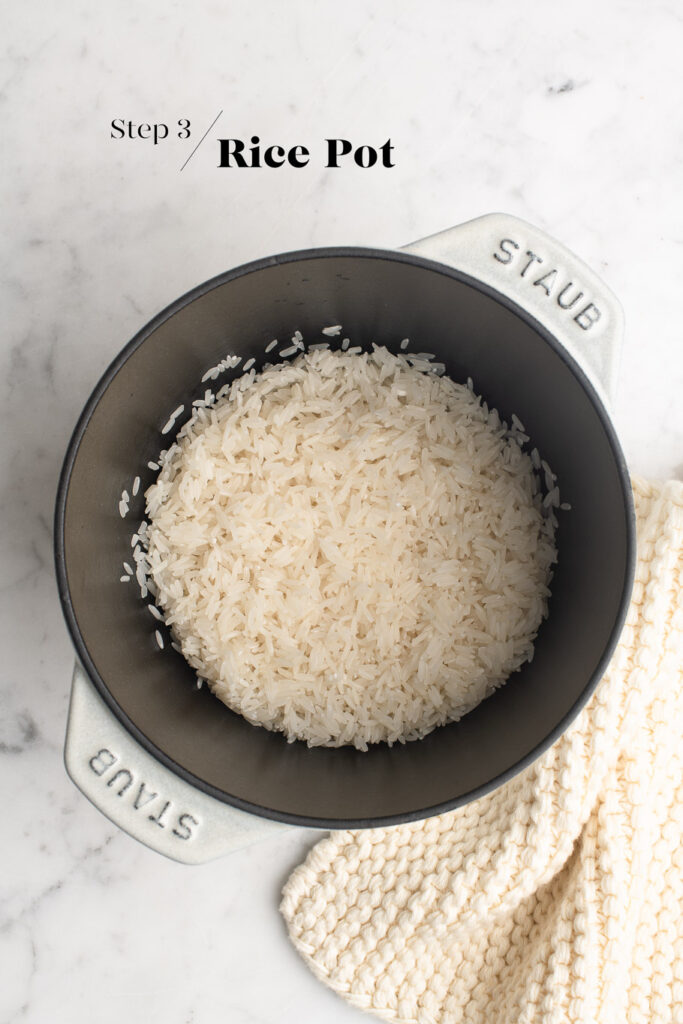
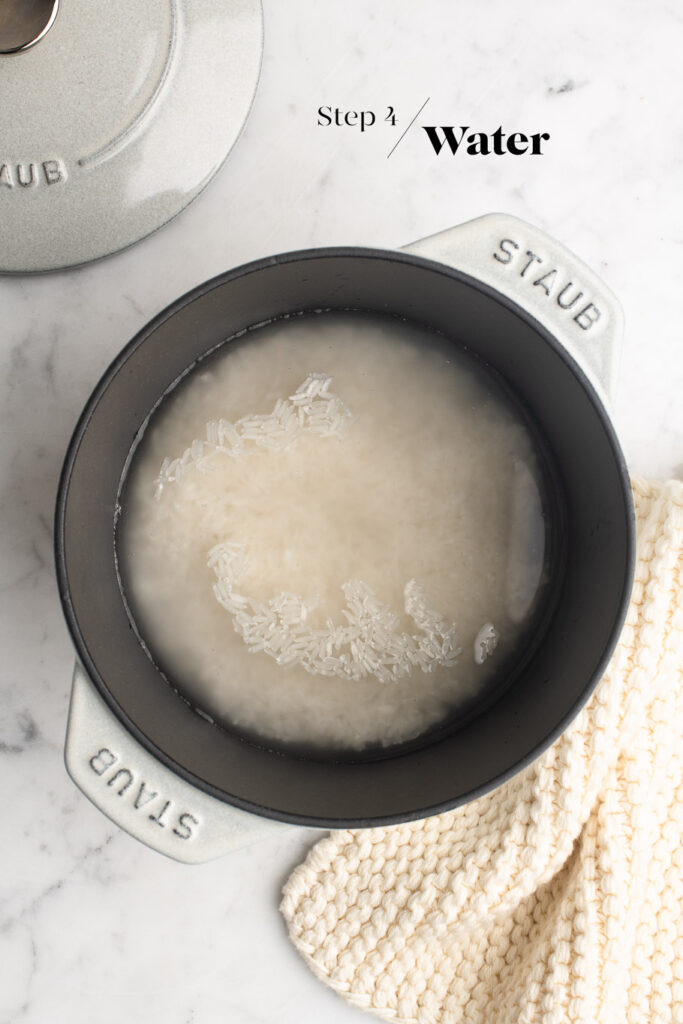
Step 5
Place the lid on the saucepan. Cook the rice over low to medium heat for 30 minutes. The water should not boil; it should just simmer gently.
After 30 minutes, remove the saucepan from the heat and allow the rice to continue resting and steaming for about 10 minutes. Fluff the rice before serving.
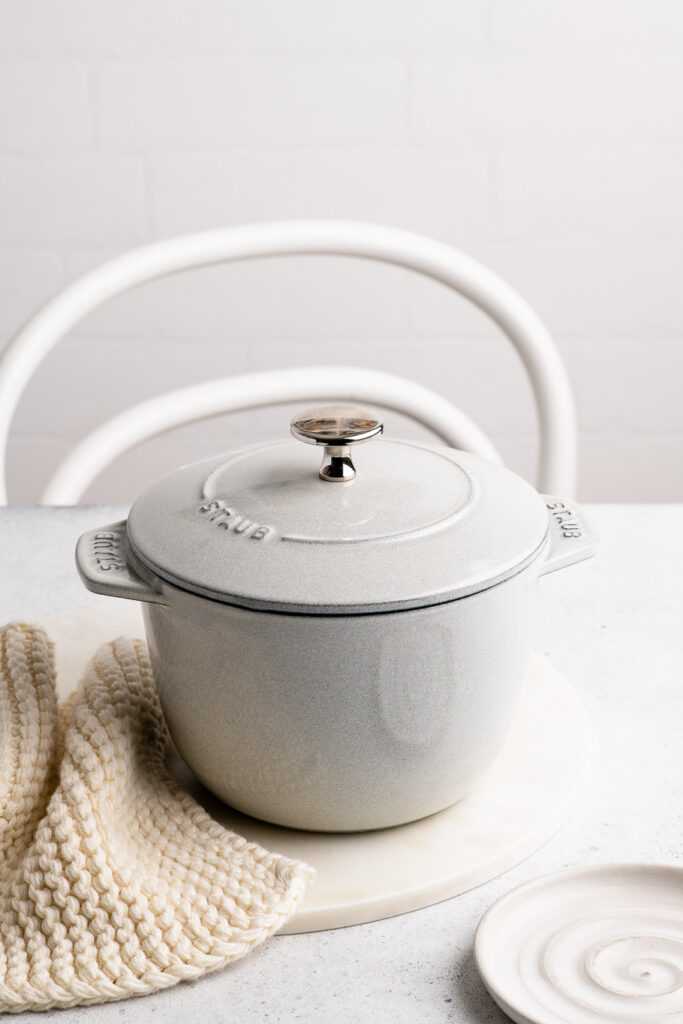
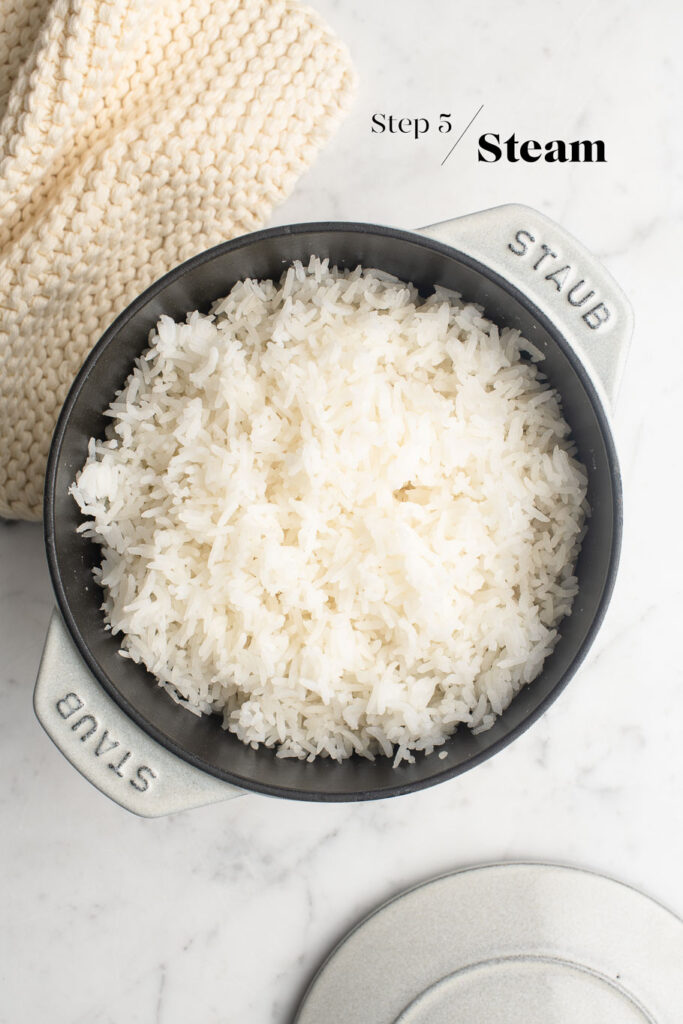
Tips for Cooking Rice on the Stove
- Rinse the rice. This step removes the excess starch and impurities on the grains of rice. If you don’t rinse the rice, you might end up with claggy rice. Some recipes tell you to skip this step, and they claim that it makes no difference to the finished dish. I disagree – rice connoiseurs (aka Asian mamas) will know 😉
- Use a cast-iron pan. Cast-iron distributes the heat evenly, and it also retains heat better and for longer. With my method for cooking rice below, I have never had burnt rice when using a cast-iron pan.
- Use a stainless steel pan with a tight-fitting lid. Before I converted to a cast-iron pan for cooking rice, I used an everyday stainless steel pan which did the job perfectly. Make sure you use one with a tight-fitting lid so that the steam does not escape. If your lid has a small vent to let the steam out, cover this vent with a damp cloth during cooking.
- Use a glass lid. A glass lid will help you to see what is going on in the pan without having to remove the lid and let the steam escape. This is particularly helpful if you are new to making rice on the stove. Once you have cooked rice this way many times, you will begin to trust the process and a glass lid will not always be necessary.
- Do not peek. If you don’t have a glass lid, resist the temptation to lift the lid to see how the rice is cooking. If you allow too much steam to escape, the rice can end up dry.
- Experiment with the heat settings. Every stove is different! Also, what type of saucepan you use may also affect your cooking time. You may need to adjust your heat settings to find out what works best for you and your equipment. For cooking rice, aim for a setting where the water will gently simmer.
- Experiment with the amount of water. The recommended ratio of rice to water is 1:1.25. However, this can change depending on your personal preference, as well as the type of rice that you are using. If you follow the recipe below and find that the rice is too moist or too dry for your liking, increase or decrease the water by 1 tablespoon the next time, and keep adjusting until you find the perfect ratio.
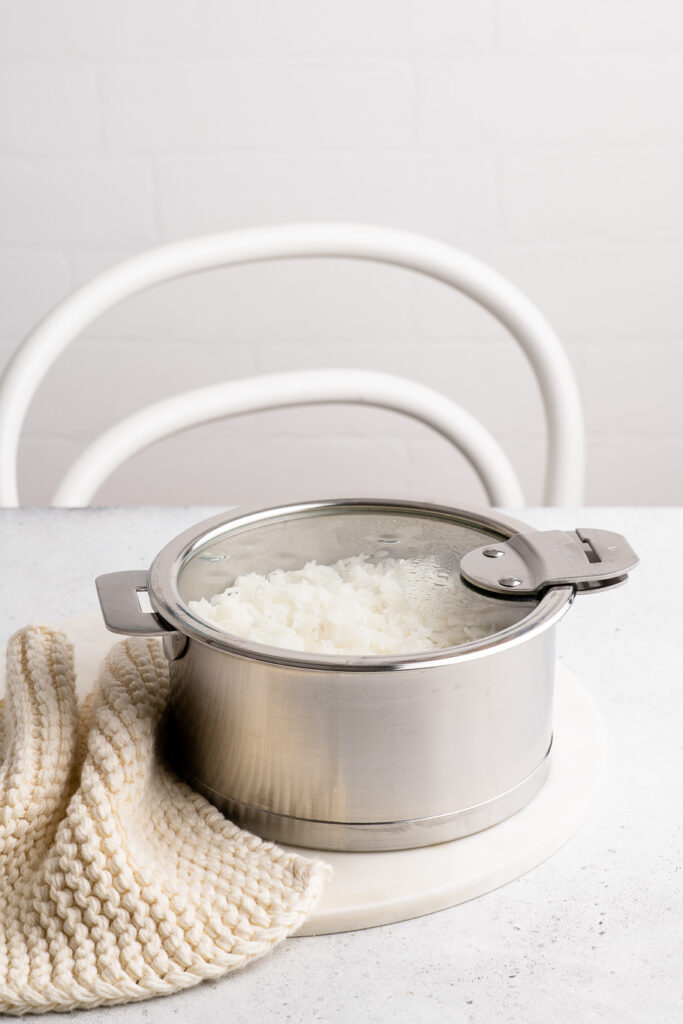
How to Freeze Leftover Rice
I have an inability to cook the right amount of noodles, pasta and rice. Even if I were to work out the exact quantities required per person, I have a compulsive habit of throwing in an extra handful or two, “just in case”.
Thankfully, leftover rice keeps very well.
Leftover rice can be kept in the fridge in a covered container for several days, and quickly reheated in the microwave.
I prefer to freeze any leftover rice in portions for 1 or 1-2, either of which will allow for easy defrosting later, depending on how many you need to feed. I own a vacuum-sealer for freezing food, but you can also use regular ziplock freezer bags.
To defrost frozen cooked rice, I microwave the packages until the rice has defrosted enough so that I can pour the rice into a serving bowl. Use a fork to break up the frozen rice, and microwave again in short bursts until the rice is steaming hot.

How to Cook Jasmine Rice
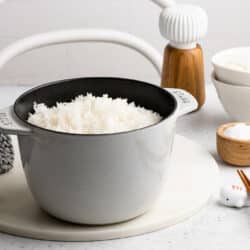
- Prep Time: 5 mins
- Cook Time: 30 mins
- Total Time: 35 minutes
- Yield: Serves 3 to 4
- Category: Dinner
- Method: Stove
- Cuisine: Asian
How to cook perfectly steamed and fluffy Jasmine rice on the stove, with step-by-step photos.
Ingredients
- 350 g (heaped 1 1/2 cup) Jasmine rice
- 500 ml (2 cups) cold water
Instructions
- Measure the rice into a bowl.
- Transfer the rice into a fine sieve through which the rice grains cannot escape.
- Wash and rinse the rice under a cold tap until the water runs clear. Use your hands to gently move the rice around the sieve. At first, the water will appear milky and cloudy, but as the starch rinses away, the water will start to look clear.
- Shake the sieve to remove as much excess water as possible.
- Transfer the rinsed rice to a medium-sized saucepan with a tight-fitting lid. I like to use a cast-iron pot to cook my rice, but any stainless steel pan will work as well.
- Measure the water.
- Pour the water over the rice in the saucepan.
- Cover the saucepan with a lid.
- Place the saucepan on the stove.
- Cook the rice on low to medium heat for 30 minutes. The water should not come to a boil; it should just gently simmer so that the rice will cook slowly and gently. A glass lid will help you to see how the rice is cooking.
- After 30 minutes, turn off the stove and remove the saucepan from the heat source.
- Let the rice continue to steam for about 10 minutes, but you can skip this step if you are in a hurry.
- Fluff the rice before serving.
Kitchen Notes
 WHAT TEMPERATURE TO COOK RICE
WHAT TEMPERATURE TO COOK RICE
Each stove is different, so you will have to experiment with your stove a bit. But generally speaking, you want a low to medium heat so that the water comes to a gentle simmer. The rice will cook slowly and gently. For my Bora induction stove, I use setting 5 out of 9.
 RATIO OF RICE TO WATER
RATIO OF RICE TO WATER
For Jasmine rice, you generally need a ratio of 1:1.25 of rice to water. My recipe uses a ratio of approximately 1:1.4. I think the ratio can vary slightly according to personal preference, as well as the rice you are using. Sometimes when I change brands of rice, I find that my usual recipe yields cooked rice which is too moist or too dry. I recommend experimenting by increasing or decreasing the amount of water by 1 tablespoon at a time.
 OTHER TYPES OF RICE
OTHER TYPES OF RICE
Basmati Rice: Follow the same recipe as above, but use a ratio of 1:1.5 of rice to water.
Sushi Rice: Follow the same recipe as above.
 MY FAMILY’S RICE RECIPE
MY FAMILY’S RICE RECIPE
For my family of 2 adults and 2 kids, we use 280 g rice (2 rice cups) : 400 ml water. I’m putting this note here because my daughter cooks the rice for our family 🙂
 FREEZING LEFTOVER RICE
FREEZING LEFTOVER RICE
Leftover rice can be frozen in small portions in vacuum-sealed bags or ziplock freezer bags.
 CONVERSIONS
CONVERSIONS
To convert from cups to grams, and vice-versa, please see this handy Conversion Chart for Basic Ingredients.
 OVEN & STOVE TEMPERATURES
OVEN & STOVE TEMPERATURES
All recipes on this website have been tested on an induction stove and/or with a conventional oven (i.e. an oven without fan). All recipes on this website use temperatures for a conventional oven, unless otherwise mentioned. Convection ovens (i.e. fan-forced ovens) are typically 20°C/70°F hotter than conventional ovens, but please check your manufacturer’s handbook.
 Print
Print Pin Recipe
Pin Recipe Rate
Rate
Great instructions! I used a stainless steel pan and the rice came out perfectly. I even bought a glass lid so I could see how the rice was cooking – great tip!
I love the grey rice pot!